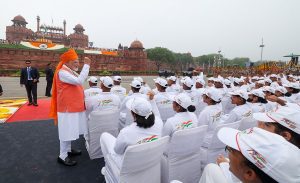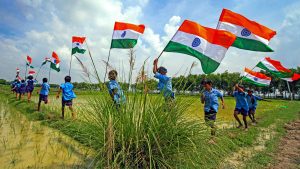The 79th Independence Day represents a moment of immense pride for every Indian citizen. Our great nation has successfully demonstrated how, despite facing tremendous socioeconomic challenges, a country as vast and diverse as India can evolve from a democratic experiment into a model democracy. This historic day commemorates the unprecedented collective effort of countless Indians who united to gain independence from colonial rule.
A single person, ideology, or organisation never drove the independence movement. Instead, it encompassed the tireless efforts of hundreds of thousands of patriots who transcended religious, caste, regional, and political divisions. This unity in diversity remains India’s greatest strength and should be the cornerstone of any Independence Day political rhetoric.
 However, recent addresses have failed to underscore this fundamental spirit. Instead of celebrating our collective heritage, the speeches have increasingly resembled partisan political addresses that divide the nation rather than unite it.
However, recent addresses have failed to underscore this fundamental spirit. Instead of celebrating our collective heritage, the speeches have increasingly resembled partisan political addresses that divide the nation rather than unite it.
The contemporary Independence Day political rhetoric has, unfortunately, included attempts to discredit previous Prime Ministers and political parties who have served the country with distinction. A particularly concerning trend involves incorrectly suggesting a lack of technological progress in previous governments, which conveniently overlooks massive historical contributions.
Also, Please Read: Independence Day 2025, 79th Anniversary Celebration.
Jawaharlal Nehru’s visionary leadership established foundational institutions, including ISRO, IIMs, IITs, AIIMS, HAL, DRDO, and the Bhabha Atomic Research Centre. These institutions continue to serve as pillars of India’s technological and educational infrastructure. Indira Gandhi continued these endeavours by facilitating India’s first citizen to orbit space through Squadron Leader Rakesh Sharma’s mission, ordering underground nuclear tests, and initiating the national mission on seabed mining.


These represent massive milestones in India’s technological journey. Discounting and underplaying the contributions of previous national leaders through Independence Day political rhetoric constitutes a serious disservice to our country’s rich history and democratic traditions.
Current Independence Day political rhetoric frequently seeks credit for India becoming the world’s fourth-largest economy. While this achievement deserves recognition, the complete picture requires deeper analysis beyond macroeconomic data. The claim misses entirely an examination of average economic indicators that affect ordinary citizens.
From a per-person perspective, India, with approximately 140 crore people, remains classified among lower-middle-income countries with a per-capita GDP of $2,711. For comparison, Sri Lanka maintains a per-capita GDP of $4,325, while Bhutan achieves $3,913. These figures provide important context often missing from Independence Day political rhetoric.
India has indeed overtaken Japan’s GDP and now targets Germany’s GDP to become the third-largest global economy. However, both countries maintain populations of approximately 12 crore and 8 crore, respectively, roughly equivalent to two Indian states. Japan’s per-capita GDP stands at $33,767, while Germany achieves $54,343. China, India’s closest population comparison, maintains a per-capita GDP of $12,614.
A genuine measure of India’s economic success must be evaluated through per-person data points, which serve as the most reliable indicators for assessing whether the nation truly punches above its weight economically.
Independence Day political rhetoric has consistently attempted to draw political advantage from Operation Sindoor. However, serious questions remain unanswered, particularly regarding claims by the United States President about ensuring a ceasefire between India and Pakistan. The continued absence of public denial regarding external involvement represents a significant departure from India’s time-tested bilateral approach to resolving Indo-Pakistan issues.
The Pahalgam terrorist attacks and subsequent Operation Sindoor expose critical accountability gaps. Security lapses revealed failures within the government’s intelligence and security machinery. This situation is further complicated by the lack of meaningful international support in unequivocally condemning Pakistan as a state sponsor of terrorism.


The electoral outcome indicates that Indian citizens have chosen a delicately balanced coalition government at the centre, rejecting attempts at constitutional manipulation through Independence Day political rhetoric.
Despite electoral setbacks, systematic attacks on SC, ST, and OBC rights continue through drastically reduced scholarships and delayed university appointments for backwards community candidates. Government figures reveal that 83 per cent of professor-level posts reserved for STs, 80 per cent for OBCs, and 6 per cent for SCs remain unfilled in central universities.
India faces significant challenges regarding balanced regional growth, with several states severely lagging. The current government has created an unhealthy strain in centre-state relations through politically biased budget allocations and manipulated government levies that deny economic benefits to various states.
Contemporary Independence Day political rhetoric must move beyond divisive politics to address these fundamental governance issues. The focus should return to real ground-level work that genuinely secures the rights and interests of backwards communities and regions.
Independence Day political rhetoric should celebrate our collective achievements while acknowledging challenges ahead. Rather than engaging in partisan politics that undermine national unity, our leaders must embrace the inclusive spirit that made independence possible. Only through genuine commitment to constitutional values, regional equity, and historical accuracy can India truly honour the sacrifice of our freedom fighters and build a stronger democratic future.
The 79th Independence Day reminds us that our greatest strength lies not in political rhetoric, but in our unity, diversity, and shared commitment to democratic principles that have guided our nation since independence.

